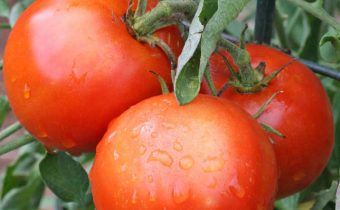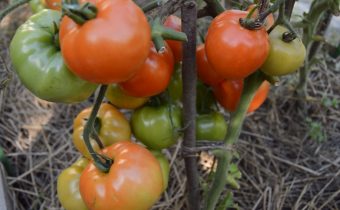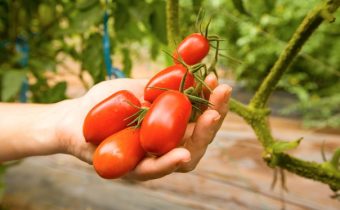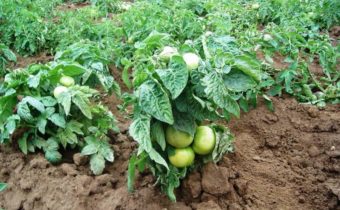Tomato "Tsunami": a great variety for growing in the greenhouse
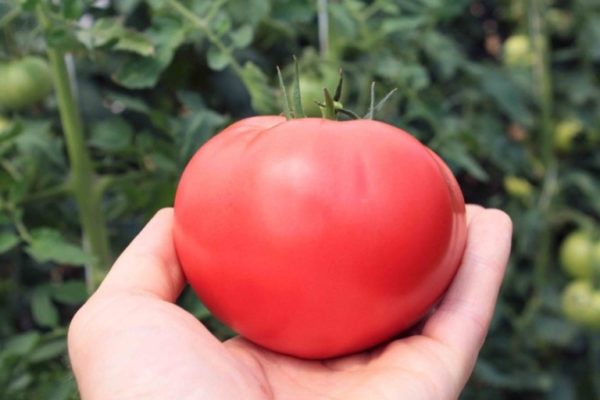
So it turns out that pink tomatoes are considered to be the most delicious among vegetable growers - either their color or the sugar-colored pulp attracts attention. Pink tomato varieties are guaranteed to occupy an honorable place in many collections of summer residents.
One of the noted for the taste of tomatoes, called "Tsunami". Characteristics and description of the variety allow, according to reviews, to mark it as worthy for use in central Russia, especially for growing in greenhouses.
It is a mid-early variety, its fruits ripen in 110 -117 days after germination. The plant is medium thick, thermophilic. Productivity - up to 3.5 kg from one bush.
Plant description
 Tomato bush weakly branching, up to 60 cm high, is formed in 1-2 stems. Leaves are green, corrugated. The plant lays 6-7 brushes, each of which is up to 5 large tomatoes
Tomato bush weakly branching, up to 60 cm high, is formed in 1-2 stems. Leaves are green, corrugated. The plant lays 6-7 brushes, each of which is up to 5 large tomatoes
The fruits have a spectacular appearance:
- The average weight of tomato 230-250g. Maximum - up to 300g.
- The color of ripe fruit is pearl pink.
- The shape is flat-round, somewhat ribbed.
- The fruits have a pleasant harmonious taste.
- The skin is thin, the pulp is juicy.
- Tomatoes are used fresh, in salads and in the manufacture of juices and ketchups.
Diseases and pests
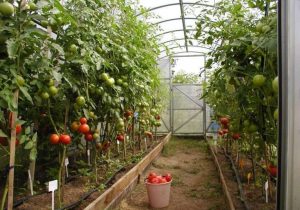 The variety is resistant to tobacco mosaic virus, moderately resistant to fusarium. It is affected by phytosporosis and cladosporiosis.
The variety is resistant to tobacco mosaic virus, moderately resistant to fusarium. It is affected by phytosporosis and cladosporiosis.
To avoid these diseases, plants are planted as early as possible, using greenhouses and film shelters. This allows you to get the main crop before the autumn fogs and the appearance of phytophthora.
For the prevention of viral and fungal diseases, it is necessary to provide for seed treatment with disinfectants before planting seedlings. For this purpose, a solution of potassium permanganate or Fitosporin is used.
- The frame and walls are washed with a disinfectant solution.
- Tapestries and inventory are disinfected.
- The land in the greenhouse should be changed whenever possible every 3-4 years. If this is not possible, it is treated with biological products - Radiance-1, Fitosporin.
- In case of severe contamination, the soil is treated with chemical agents - Bordeaux mixture, potassium permanganate.
- To reduce the acidity used dolomite flour, lime or ash.
Another method that helps protect plants from disease is the proper use of crop rotation. The best precursors of tomatoes in the greenhouse are cucumbers and other pumpkin crops.
See also: Tomato variety "Spasskaya Tower F1", yield, photos and reviews
With the likelihood of infection with late blight, use biological remedies - Fitosporin or chemical drugs - Bordeaux mixture or copper oxychloride. Many gardeners to fight infections use folk remedies - a mixture of solution of infusion of garlic or wormwood with ashes and soap.
Against wireworm, basudine is an effective remedy. However, the use of chemicals in small areas is impractical - rather carefully examine the plants and monitor their development.
In small areas, chemicals against these pests are rarely used, mainly using a sprinkling of decoction of wormwood, bitter pepper, garlic mixed with infusion of ash and laundry soap. As a deterrent is also used soap solution of birch tar.
Advantages and disadvantages
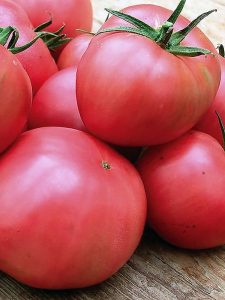 The main advantage of the tomato tsunami, according to reviews, is the wonderful taste of sweet and large fruits. Judging by the photos, their appearance is no less attractive, and the yield for such large-fruited tomatoes is quite high.
The main advantage of the tomato tsunami, according to reviews, is the wonderful taste of sweet and large fruits. Judging by the photos, their appearance is no less attractive, and the yield for such large-fruited tomatoes is quite high.
The disadvantages of the variety include their susceptibility to diseases, especially late blight. To preserve the harvest of tomatoes, it is necessary to take additional measures for the care and formation of plants.
Fruits with delicate skin do not tolerate transportation; they crack when preserved.
Plant Care
Taking into account the peculiarities of the “Tsunami” variety, during the whole growing season of the plant, it is necessary to observe the appropriate measures. It is necessary to start preventive work with seed treatment, and continue the entire period of growing seedlings and after planting it under film shelters and in greenhouses.
The soil
Land for seedlings is prepared from a mixture of decontaminated garden land with compost, mineral fertilizers and ash. The main thing is that the soil was nutritious, and at the same time loose and breathable.
See also: Growing a tomato according to the method of IM Maslova
Seedling
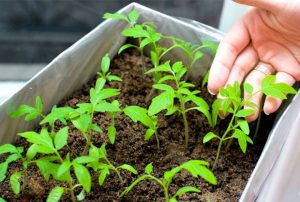 Prepared tomato seeds are sown in a moistened ground of seedling boxes through 2-3 cm, covered with a small (5-7 mm) layer of soil. Boxes tightly, but not tightly closed and removed closer to the batteries or other warm places in the apartment. When the first loops appear - sprouting, the boxes are moved to bright places - window sills or under lamps of artificial lighting.
Prepared tomato seeds are sown in a moistened ground of seedling boxes through 2-3 cm, covered with a small (5-7 mm) layer of soil. Boxes tightly, but not tightly closed and removed closer to the batteries or other warm places in the apartment. When the first loops appear - sprouting, the boxes are moved to bright places - window sills or under lamps of artificial lighting.
In the first two weeks it is necessary to provide plants with lighting for 11-12 hours per day, the temperature at this time is maintained at night - 12-14 degrees, in the daytime - 15-16.grad. In the following days, the temperature is increased by 5-7 degrees with maximum illumination.
Finished seedlings should have healthy green leaves, a strong trunk and a well-developed root system. The optimum is the age of seedlings planted in the soil - 50-55 days.
Transplant to greenhouse
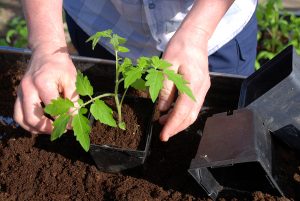 Since Tsunami varieties are characterized by weak resistance to infections, they try to plant seedlings at the earliest possible time, for which they use greenhouses or temporary film shelters.
Since Tsunami varieties are characterized by weak resistance to infections, they try to plant seedlings at the earliest possible time, for which they use greenhouses or temporary film shelters.
Compost, mineral fertilizers, and biohumus are added to the soil before planting. Plants are planted at a distance of 40 cm, watered and fastened to the pegs.
Forming a bush
In order for the plant to feel comfortable in a greenhouse, it must be properly formed. Tomatoes are formed in a greenhouse in 1-2 stems, stepchildren are removed immediately after formation. The pasting and cutting of the lower leaves is done in the morning, it is recommended to not water the tomatoes for 24 hours.
See also: Description of the early ripe cultivar of tomatoes "Katya F1"
Care
The use of greenhouses, with all the benefits - the creation of a comfortable microclimate, protection from wind and temperature changes, often has a negative impact on the development of plants.
Tomatoes do not tolerate dry soil, but increasing the humidity in the greenhouse can have an even more detrimental effect.
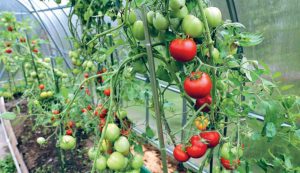 In order to prevent the development of pathogenic bacteria in a humid warm environment, it is necessary to ventilate the greenhouse, and it is desirable to mulch the soil. This will keep the moisture around the roots of the tomatoes and reduce evaporation, and hence the humidity.
In order to prevent the development of pathogenic bacteria in a humid warm environment, it is necessary to ventilate the greenhouse, and it is desirable to mulch the soil. This will keep the moisture around the roots of the tomatoes and reduce evaporation, and hence the humidity.
As mulch is best to use mowed grass or hay. A layer of mulch will inhibit the growth of weeds, which are also often sources of various infections.
To maintain low air humidity in greenhouses and hotbeds, it is recommended that watering be performed directly under the plant root, preferably in the morning from 10 to 14 hours.
Plant feeding is carried out before the fruit is set every 10-12 days with green fertilizer - a solution of mullein infusion (1:10), then transferred to mineral fertilizers.
Proper and timely compliance with agrotechnics will allow you to get a full harvest of beautiful pink fruits.
Video: How to grow good tomatoes in the open field at the cottage


